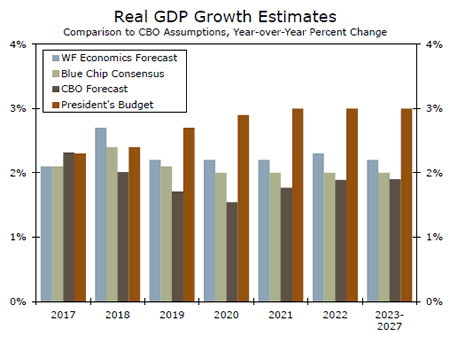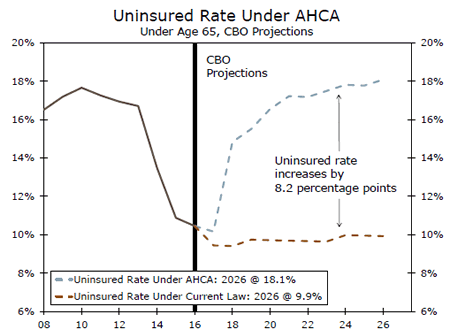U.S. Review
Quieter Week Reiterates Generally Solid Fundamentals
- New information released this week pertaining to the housing market showed that sales of new and existing sales slipped in April after getting an early start to a very robust spring selling season.
- Durable goods orders slipped less than expected though core orders also unexpectedly declined.
- The second look at Q1 GDP was better; the economy expanded 1.2 percent rather than 0.7 percent. We still expect a solid bounce back in Q2.
Monthly Home Sales Data Hide Robust Spring Sales
New and existing home sales in April were released this week, and both slipped further than expected. New homes sales were down 11.4 percent on the month and existing sales were down by 2.3 percent. April’s 569,000-unit pace of new home sales follows an upwardly revised 642,000-unit pace in March which marks the cycle-high for the series. Sales of existing homes were also coming down from hitting a cycle high of 5.7 million-units in March. April resales were running at a still-strong 5.57 millionunit pace. The mild winter weather in the Midwest and Northeast allowed an earlier start for the spring selling season, pulling transactions that usually take place in April into earlier months. During the first four months of the year, new home sales were up an impressive 11.3 percent compared to the same period last year. Existing home sales were up 4.1 percent compared to the first four months of last year.
Resales are being held back by very low inventory of homes on the market. Even with a 7.2 percent rise in for-sale inventory on the month, there were 9 percent fewer homes on the market in April 2017 than a year ago. Competition between buyers is significant; the average home sold in April was on the market for just 29 days—the shortest point since the NAR tracked the series in 2011. One factor that may be holding homeowners back from selling is concern about finding a new home.
Housing demand is strong, supported by the healthy job market and continued recovery in household finances. Demographic factors are also starting to turn in favor of homeownership. The first quarter of 2017 marked the first time during the current cycle that household formation for homeowners outpaced rental household formation. Similarly, momentum is shifting from multifamily homebuilding to single-family and from urban markets to well-connected suburbs. Homebuilders are the most optimistic in over a decade and are seeing strong shopper traffic. For these reasons, we remain positive on housing for the year even if we do see some payback in Q2 after the strong print for Q1 residential investment in GDP.
Recent data from the factory sector have been mixed. Headline durable goods orders slipped 0.7 percent in April, which was a smaller drop than expected, and March orders were revised much higher. However, durable goods orders ex-transportation declined unexpectedly. Shipments of nondefense capital goods, ex-aircraft, our preferred measure of business equipment spending, slipped in April following a downward revision to March. Recent survey data from the factory sector has also been quite mixed. It appears the gap between the hard and soft data we have noted since the election are beginning to converge, but at a slower pace than soft data had indicated earlier.
The second look at Q1 GDP was an improvement on the first, with the economy expanding 1.2 percent as personal consumption expenditures was revised from just 0.3 percent to 0.6 percent, adding 0.2 percentage points more to headline. Fixed investment and net exports also added more to Q1 growth than first reported, while government spending was less of a drag.
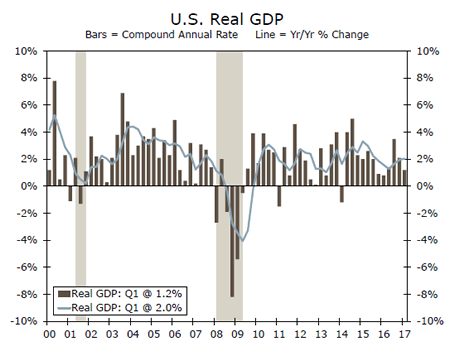
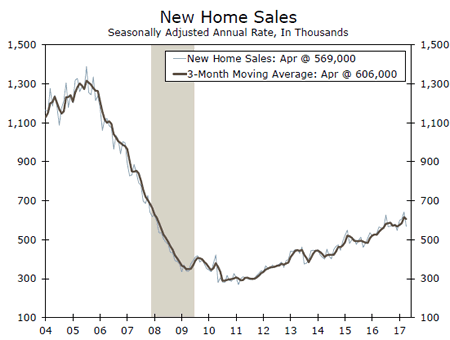


U.S. Outlook
Personal Spending • Tuesday
Real consumer spending started the year at just 0.3 percent in the first quarter, the slowest pace since October 2009. The downshift has been attributed to softer utilities spending but, in our view, the slower pace had more to due to a tax policy change that went into effect this year. Households filing for the Earned Income Tax Credit and the Childcare Tax Credit had their tax refunds held until February 15th. Recent consumer sector data, including retail sales data point towards a bounce back in consumer spending in Q2. Now that the delayed tax refunds are flowing to households, we expect consumer spending to make up ground in the second quarter. Our forecast calls for 3.0 percent real consumer spending in Q2. We expect nominal consumer spending to rise 0.4 percent in April, setting up a solid start to the quarter. With continued wage gains and steady employment growth, we see consumer spending rising to average 2.4 percent over the final two quarters of this year.
Previous: 0.0% Wells Fargo: 0.4% Consensus: 0.4% (Month-over-Month)
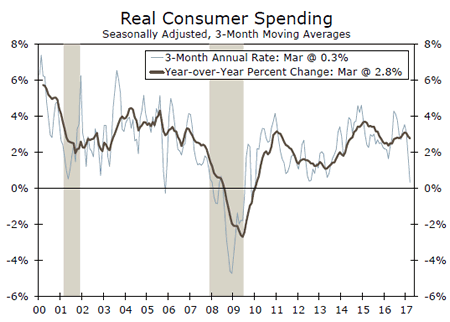
ISM Manufacturing • Tuesday
Manufacturing sentiment, as measured by the ISM manufacturing index, downshifted in April to 54.8 from March’s 57.2 reading. The production subcomponent continued to show improvement, however, the new orders component softened for the month. The closely watched employment component also weakened on the month. We expect a bounce back in the headline index reading for May to 55.2. We continue to expect the industrial sector to slowing improve this year as global growth begins to firm and domestic business investment slowly begins to pick up once again. Our expectation is that industrial production will accelerate to around 3.0 percent in the second quarter, making up ground lost in Q1 before averaging 2.4 percent in both the third and fourth quarters of this year.
Previous: 54.8 Wells Fargo: 55.2 Consensus: 54.9
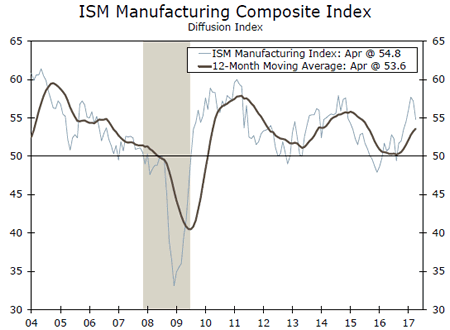
Employment Situation • Friday
Following a disappointing March report which showed job gains of just 79,000, hiring activity accelerated in April, climbing 211,000. The unemployment rate continued to decline and now stands at 4.4 percent. Looking at the year-over-year change in nonfarm employment growth it is clear how stable the pace of job gains has been over the last few months, with only a very slight downshift recently. We expect the pace of job growth to maintain this steady pace once again in May with employers adding 185,000 jobs. We look for the unemployment rate to remain steady at 4.4 percent as the labor force participation rate climbs slightly higher. We expect the pace of job growth to average around 177,000 in Q2 and then gradually downshift in the third and fourth quarters of this year. We also expect the unemployment rate to remain steady at 4.4 percent through the end of this year.
Previous: 211,000 Wells Fargo: 185,000 Consensus: 180,000
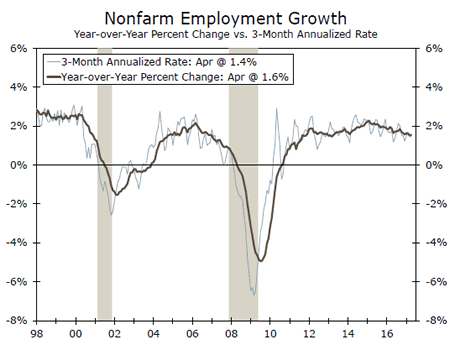
Global Review
Increasingly Self-Sustaining Expansion in the Eurozone
- Sentiment indicators in the Eurozone are quite strong at present. The manufacturing PMI in the euro area rose to a multi-year high in May, and the Ifo index of German business sentiment stands at its highest level since reunification.
- That said, the actual state of the Eurozone economy does not appear to be as strong at present as the sentiment indicators would suggest. However, the expansion is becoming increasingly self-sustaining. Accordingly, we look for real GDP in the Eurozone to accelerate modestly in coming quarters.
Increasingly Self-Sustaining Expansion in the Eurozone
Data released this week showed that business confidence in the Eurozone continues to strengthen. As shown in the graph on the front page, the manufacturing PMI in the Eurozone rose to 57.0 in May, its highest reading in six years. The comparable index for the service sector edged down a bit in May, but it remains at an elevated level. Taken at face value, the strength of the PMIs suggests that the Eurozone economy is booming at present. Business sentiment in Germany, the single largest economy in the euro area, also is robust at present. The Ifo index of German business sentiment rose in May to its highest level since German reunification occurred in 1991 (top chart). Likewise, a widely followed index of consumer confidence in Germany edged up to its highest level in at least 12 years.
That said, there seems to be some disconnect at present between the strength in sentiment indicators and actual growth in economic activity. In Germany, industrial production (IP) was up only 1.1 percent on a year-ago basis in the first quarter of the year. With the Ifo index at its highest level in at least 26 years, it would be reasonable to expect that growth in German IP would be significantly stronger at present than just 1 percent. Perhaps IP growth in Germany will strengthen in coming months. In that regard, the volume of manufacturing orders, which was up 2.3 percent in Q1, does point to some acceleration in production going forward.
Although the actual state of economic growth in the euro area at present may be a bit disappointing in light of the strength in sentiment indicators, there are signs that the expansion is becoming increasing self-sustaining. Data released this week showed that real GDP in Germany grew at an annualized rate of 2.4 percent on a sequential basis in the first quarter, which confirmed the preliminary estimate that was released a few weeks ago (middle chart). But the new details on the spending components that were available this week showed that domestic demand was an important driver of real GDP growth in Germany in Q1. Although real personal consumption expenditures grew only 1.2 percent in Q1, growth in investment spending was quite strong. Business spending on machinery equipment rose 5.0 percent while construction spending shot up 9.5 percent.
The Spanish economy tanked during the global financial crisis and its immediate aftermath—real GDP contracted nearly 10 percent between 2008 and 2013—but growth has been quite strong in recent years. Real GDP in Spain grew 3.2 percent in both 2015 and 2016, an annualized pace of growth that was maintained in Q1-2017 (bottom chart). The data on GDP spending components in the first quarter that were released this week showed that domestic demand remains the primary driver of economic growth in Spain.
Although recent sentiment data in the Eurozone may be overstating the actual strength of economic activity, there are signs that the economic expansion that is underway is becoming increasingly self-sustaining. Indeed, we look for real GDP in the Eurozone to accelerate modestly in coming quarters.
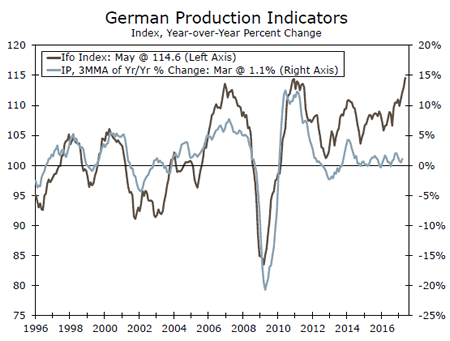
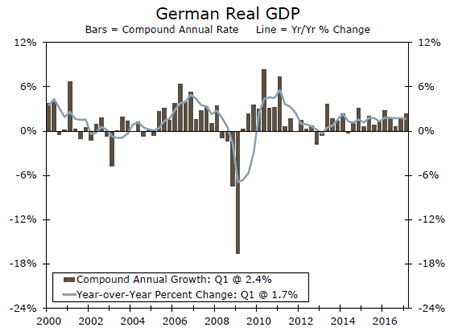
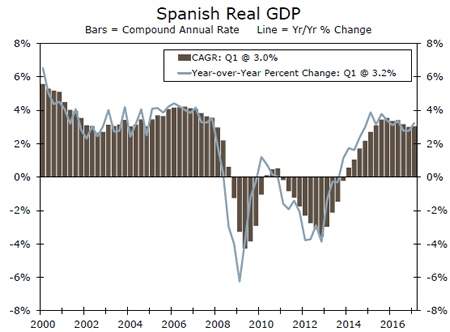
Global Outlook
Chinese PMI • Wednesday
The Chinese economy grew 6.9 percent on a year-over-year basis in the first quarter. Some indications for how the second quarter is shaping up will be released next week with an early indication of business activity in May. The official PMI, which better captures large and often state-owned enterprises is out first with a scheduled release date of Wednesday. This measure had been trending higher but gave up some ground in April. That said, this measure is still above the 50 line of demarcation and as such is consistent with a modest pace of expansion.
The Caixin PMI for China is due out the following day. This barometer of small and medium sized private-sector businesses has been skating on thinner ice in recent months. In fact, the April print of 50.3 is dangerously close to slipping into contraction territory.
Previous: 51.2 Consensus: 51.0
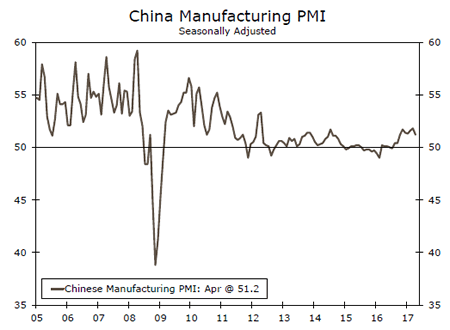
Eurozone CPI • Wednesday
Initial estimates of first quarter GDP show that the Eurozone economy grew 0.5 percent in the period to keep the growth rate steady at 1.7 percent as the economic expansion in Europe continues. Purchasing manager surveys in recent months have hit levels last seen when the European economy dodged a bullet in the wake of the sovereign debt crisis in 2010. Yet despite these positive indicators, inflation has not taken off.
The year-over-year rate of CPI inflation in the Eurozone was 1.9 percent in April; the core CPI rate was just 1.2 percent. Modest though that may be, the 1.2 percent rate of core inflation was an uptick in the rate as the nearby chart shows. If that upward trajectory continues, the ECB may turn more hawkish at its June 8th policy meeting.
Previous: 1.9% Consensus: 1.5% (Year-over-Year)
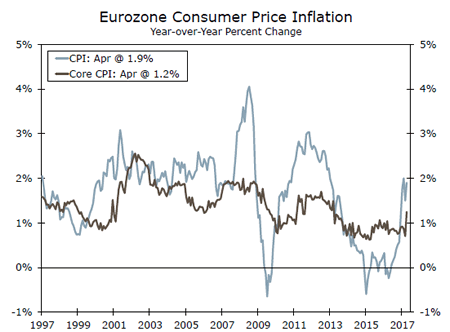
Canadian GDP • Wednesday
The weak backdrop for oil and commodity prices introduced a significant degree of weakness in business spending in Canada over the past couple of years. Since oil prices have moderated somewhat in the second half of last year, real GDP growth has increased for two consecutive quarters.
On Wednesday of next week, we will get the initial estimate for first quarter GDP growth in Canada. Retail sales increased in two out of three months in the first quarter which bodes well for consumer spending—a stalwart driver of growth in this expansion in Canada. Three straight monthly gains in wholesale trade sales and a more modest pickup in shipments suggest some help from business spending as well. The annualized pace of growth in the fourth quarter of 2016 was 2.6 percent, and we expect the growth rate in Q1 will be roughly the same.
Previous: 2.6% Wells Fargo: 2.5% Consensus: 4.3% (CAGR)
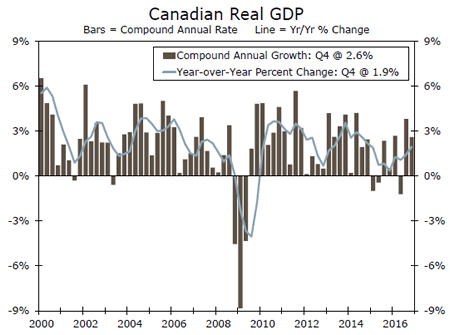
Point of View
Interest Rate Watch
A Slower Road to Normalization
The minutes of the early May FOMC meeting contained few surprises but did spell out a plan to begin to normalize the Fed’s balance sheet. FOMC members spent a great deal of time downplaying the weak first quarter economic data and mentioned repeatedly that they felt any shortfall in growth was transitory. There was a bit more concern about the inability of inflation to reach and maintain the Fed’s preferred 2 percent threshold but once again most members agreed that the pull back in reported inflation was temporary and likely due to several one-off factors.
The FOMC appears to feel much more confident about the employment data and some members even worried that if the unemployment rate falls further, which it has already done, then inflation could overshoot the Fed’s target. Most members did not feel this way, however, and the markets interpreted the Fed’s comments as being slightly dovish, or at least a bit more cautious than had been expected.
Financial market participants feel fairly certain the Fed will raise the federal funds rate target by a quarter percentage point in June but the tone of the Fed’s comments left some doubts beyond that. We still expect another quarter-point hike in September and then look for the Fed to begin to reduce the size of their balance sheet toward the end of the year.
The Fed staff’s recommendation on how to reduce the balance sheet was the biggest takeaway from the minutes. The Fed plans to gradually reduce the balance sheet by announcing a small amount of securities to be allowed to run off and not reinvested and then gradually raise that target.
The Fed’s guarded optimism on the economy and cautious stance on balance sheet normalization was interpreted to suggest that interest rate hikes may be a little slower and that the balance sheet will remain larger for longer. Demand of intermediate-term securities thus increased. The yield on the 5-year Treasury note fell notably following the release of minutes, while yields on 2-year and 10-year notes were less impacted and ended the week close to their week-ago levels.

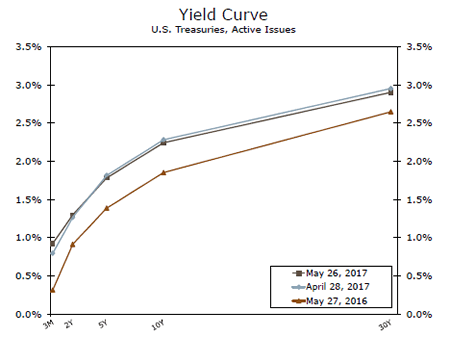
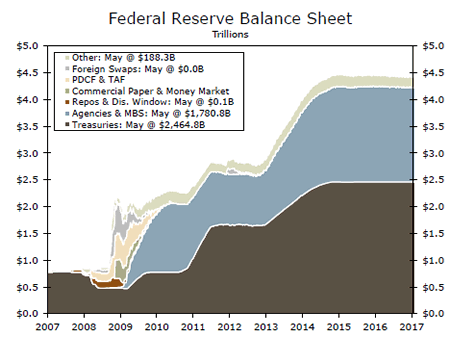
Credit Market Insights
Historical Look at Household Debt
Earlier this month, the New York Fed released a report (Household Borrowing in Historical Perspective) examining the newly released Q1-2017 Quarterly Report on Household Debt and Credit. The report showed a continuance in the trend of rising household debt levels for the 11th consecutive quarter, up $149 billion to $12.73 trillion. While the nominal nature of the data removes some significance of the streak, the report reveals some interesting trends and shifts when examining household debt and credit historically.
Data on household debt were not measured until 1999, but based on estimates, the level displayed a 63-year upward trend until 2008, hitting a 5-year run of declining balances. Following this aberration, debt balances began to recover, reaching 2008 levels in Q1-2017. However, the composition of household debt has shifted since that time in both the type of debt and holder. Mortgage balances have shrunk in favor of auto and student loans, while the borrower profile has shifted towards older and more creditworthy persons. These shifts have contributed to the improvement in delinquency rates. Delinquencies peaked during the recession, and are currently at levels below or near lows since 2000 in all categories with the exception of student loans. Student loan delinquencies have consistently worsened since 2004, and part of this could be explained by the rapid growth in the balance of student loans compared to other categories.
Topic of the Week
Budget Wonks Need the Long Weekend
This week the Trump administration released its budget for fiscal year (FY) 2018 and the following decade. The administration’s projections show publicly held debt will be reduced to 60 percent of GDP by the end of the 10-year window. This goal is achieved through $3.6 trillion in spending cuts and (assumed) faster economic growth spurred by the president’s policies.
One of the most important aspects of any set of budget projections is the economic assumptions used. The top chart compares the GDP growth assumptions contained in the president’s budget relative to our forecast, the Congressional Budget Office’s (CBO) and the Blue Chip Consensus. While growth forecasts are roughly consistent in the near term, the administration’s assumptions over the long-run are much greater than our forecast as well as those of the Blue Chip and CBO.
It should be noted that while the president’s budget often garners political attention, rarely does Congress enact all or even some of a president’s proposed budget. The next major step is for Congress to assemble and pass its own budget proposal, the FY 2018 budget resolution, which will establish the spending and deficit levels for the next 10 years. This process will also help get the legislative ball rolling on tax reforms/cuts.
Also on the D.C. policy front this week the CBO released its score of the House-passed American Health Care Act (AHCA). The score was only marginally different from earlier estimates: CBO projects the bill would reduce the federal deficit by $119 billion over the next 10 years, and the number of uninsured would rise by 23 million by 2026 relative to current law (bottom chart).
The estimates from CBO show that the path forward for Congressional Republicans remains challenging. In order to keep the plan deficit-neutral, policymakers have about $19 billion a year to work with to try and make the bill more palatable in the Senate. As the health care and budget debates move forward, we will continue to update our readers on key fiscal policy developments.
